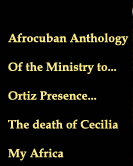The
initiate investigation intends to embrace the study
of different manifestations of the African, assumed
art and integrated in the process of continuous transculturación
that happens in the countries of the Caribbean environment.
In this initial stage, the study object has stuck
to a brief presentation of the influence of the Afro-Cuban
ritual arts in the environment of the contemporary
visual arts in Cuba like country and in the county
of Matanzas, where the practice of the Rule of Ocha
or Santería, Rule Palo Monte and other, it
is very active and it influences in the music, the
dance, the theater, the craft and the visual arts.
The
developed work demonstrates an advance in the multicultural
and organic integration that happens in the transculturación:
the artistic appropriation of relating symbolic, the
process of visual code in the plastic work, the use
of elements of the Afro-Cuban folklore, surpassing
the environment of the religious sincretismo and reflecting
the recognition on the part of the artist of an aesthetic
environment as sustenance of the contemporary plastic
work.
The
sensitive influence in a way of national life where
they are recognized by the individual utilitarian,
handmade objects, rituals, wardrobes, habits, behavior
ways and spiritual values that creates true visual
complexes and they demonstrate the rich popular imagination,
like it can be observed in the Afro-Cuban religious
altars it is influencing continually on the creation
of our painters, sculptors, ceramists, jewelers and
designers. The study of the transculturación process
and their influence in the plastic arts fundamentally
painting and sculpture that reach bigger importance
at the end of this century in Matanzas, in the works
of their artists. The Afro-Cuban ritual arts maintain
an alive tradition in several popular goods and they
continue this way a coherent dialogue, figuracionista
and singular with the artists today matanceros.
______
(1) Transculturación:
Traffic process of a culture to other and their social
repercussions of all gender. Fernando Ortiz creates
the scientific term later on recognized worldwide
by the anthropology. (Ortiz, 1940). In Note to the
Posthumous Edition of the New Catauro of Cubanismos.
Gladys Alonso, Publisher.











